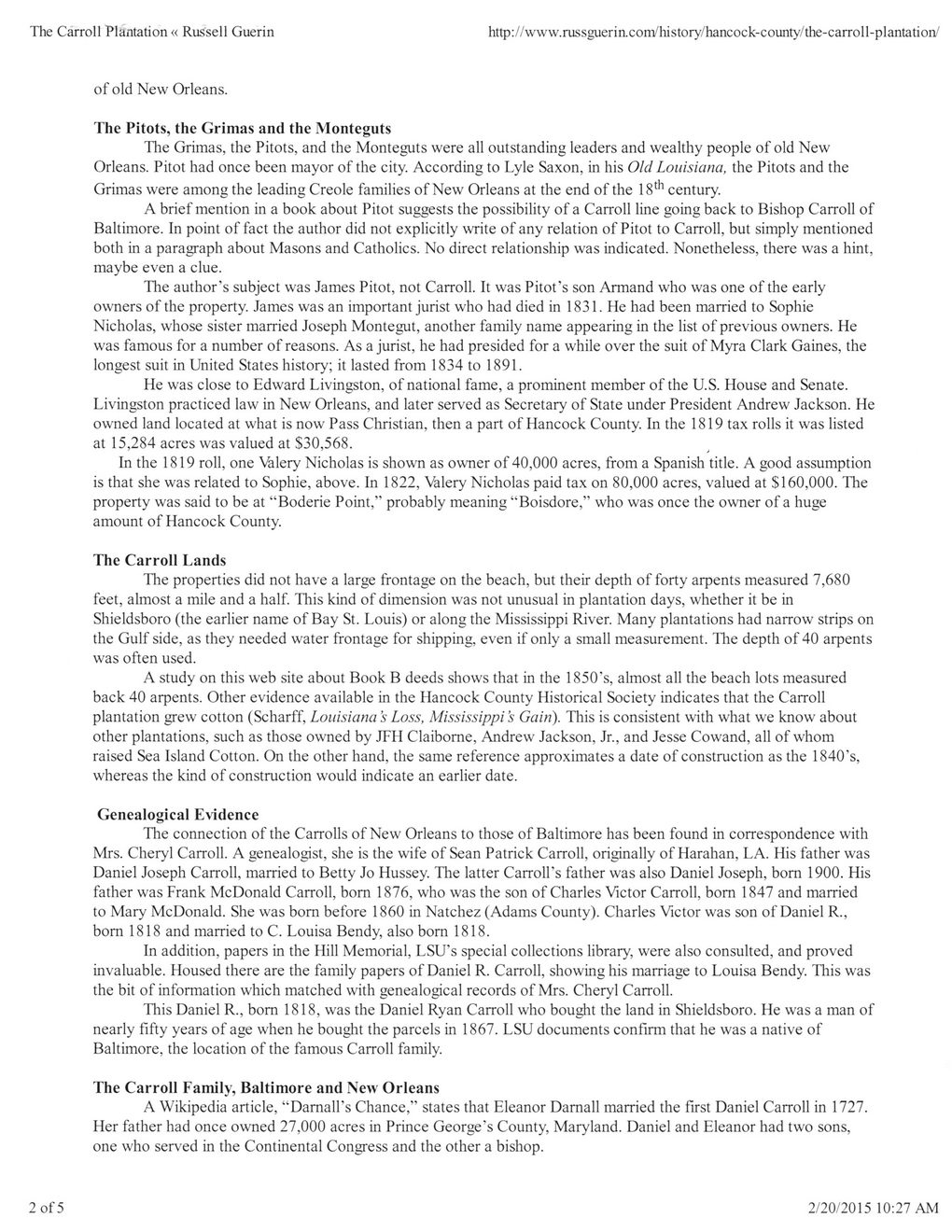This text was obtained via automated optical character recognition.
It has not been edited and may therefore contain several errors.
The Carroll Plantation « Russell Guerin http://www.russgueriacom/history/hancock-county/the-carroll-plantation/ of old New Orleans. The Pitots, the Grimas and the Monteguts The Grimas, the Pitots, and the Monteguts were all outstanding leaders and wealthy people of old New Orleans. Pitot had once been mayor of the city. According to Lyle Saxon, in his Old Louisiana, the Pitots and the Grimas were among the leading Creole families of New Orleans at the end of the 18 th century. A brief mention in a book about Pitot suggests the possibility of a Carroll line going back to Bishop Carroll of Baltimore. In point of fact the author did not explicitly write of any relation of Pitot to Carroll, but simply mentioned both in a paragraph about Masons and Catholics. No direct relationship was indicated. Nonetheless, there was a hint, maybe even a clue. The author’s subject was James Pitot, not Carroll. It was Pitot’s son Armand who was one of the early owners of the property. James was an important jurist who had died in 1831. He had been married to Sophie Nicholas, whose sister married Joseph Montegut, another family name appearing in the list of previous owners. He was famous for a number of reasons. As a jurist, he had presided for a while over the suit of Myra Clark Gaines, the longest suit in United States history; it lasted from 1834 to 1891. He was close to Edward Livingston, of national fame, a prominent member of the U.S. House and Senate. Livingston practiced law in New Orleans, and later served as Secretary of State under President Andrew Jackson. He owned land located at what is now Pass Christian, then a part of Hancock County. In the 1819 tax rolls it was listed at 15,284 acres was valued at $30,568. In the 1819 roll, one Valery Nicholas is shown as owner of 40,000 acres, from a Spanish title. A good assumption is that she was related to Sophie, above. In 1822, Valery Nicholas paid tax on 80,000 acres, valued at $160,000. The property was said to be at “Boderie Point,” probably meaning “Boisdore,” who was once the owner of a huge amount of Hancock County. The Carroll Lands The properties did not have a large frontage on the beach, but their depth of forty arpents measured 7,680 feet, almost a mile and a half. This kind of dimension was not unusual in plantation days, whether it be in Shieldsboro (the earlier name of Bay St. Louis) or along the Mississippi River. Many plantations had narrow strips on the Gulf side, as they needed water frontage for shipping, even if only a small measurement. The depth of 40 arpents was often used. A study on this web site about Book B deeds shows that in the 1850's, almost all the beach lots measured back 40 arpents. Other evidence available in the Hancock County Historical Society indicates that the Carroll plantation grew cotton (Scharff, Louisiana’s Loss, Mississippi’s Gain). This is consistent with what we know about other plantations, such as those owned by JFH Claiborne, Andrew Jackson, Jr., and Jesse Cowand, all of whom raised Sea Island Cotton. On the other hand, the same reference approximates a date of construction as the 1840’s, whereas the kind of construction would indicate an earlier date. Genealogical Evidence The connection of the Carrolls of New Orleans to those of Baltimore has been found in correspondence with Mrs. Cheryl Carroll. A genealogist, she is the wife of Sean Patrick Carroll, originally of Harahan, LA. His father was Daniel Joseph Carroll, married to Betty Jo Hussey. The latter Carroll’s father was also Daniel Joseph, bom 1900. His father was Frank McDonald Carroll, bom 1876, who was the son of Charles Victor Carroll, bom 1847 and married to Mary McDonald. She was bom before 1860 in Natchez (Adams County). Charles Victor was son of Daniel R., bom 1818 and married to C. Louisa Bendy, also bom 1818. In addition, papers in the Hill Memorial, LSU’s special collections library, were also consulted, and proved invaluable. Housed there are the family papers of Daniel R. Carroll, showing his marriage to Louisa Bendy. This was the bit of information which matched with genealogical records of Mrs. Cheryl Carroll. This Daniel R., bom 1818, was the Daniel Ryan Carroll who bought the land in Shieldsboro. He was a man of nearly fifty years of age when he bought the parcels in 1867. LSU documents confirm that he was a native of Baltimore, the location of the famous Carroll family. The Carroll Family, Baltimore and New Orleans A Wikipedia article, “Damall’s Chance,” states that Eleanor Damall married the first Daniel Carroll in 1727. Her father had once owned 27,000 acres in Prince George’s County, Maryland. Daniel and Eleanor had two sons, one who served in the Continental Congress and the other a bishop. 2 of 5 2/20/2015 10:27 AM

Carroll Plantation Guerin-Article-(2)